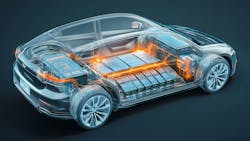Enhance EV Powertrain Performance with System-Level Simulation Modeling (Download)
Many people think of an electric vehicle (EV) as a car that’s powered by batteries instead of gas, driven by electric motors instead of an internal combustion engine (ICE). They may also think of a limited range due to the charge of the batteries and potential challenges with charging, whether at home, in the garage, or via provided charging stations.
But from a technical standpoint, many considerations in EV design can influence the performance of these and other factors. The batteries in EVs aren’t based on lead acid, but rather state-of-the-art types such as lithium-ion. They’re not 12 V DC (six-series cells), but much higher voltages (400 to 800 V DC and higher) designed with hundreds of cells connected in series or parallel combinations. Consequently, the battery design is more complex and includes not only the electrical behavior, but also thermal and structural considerations.
